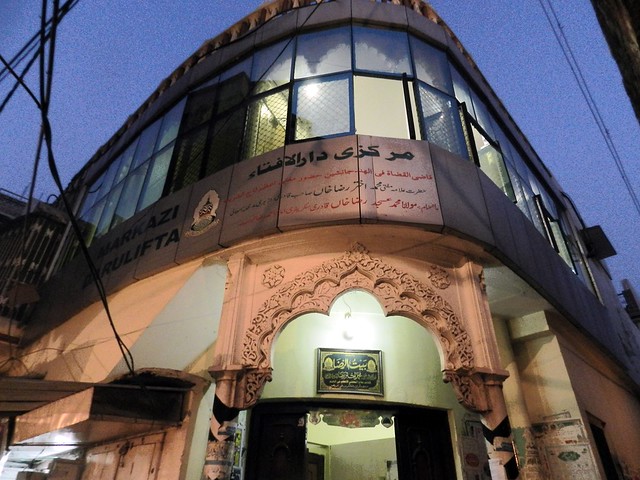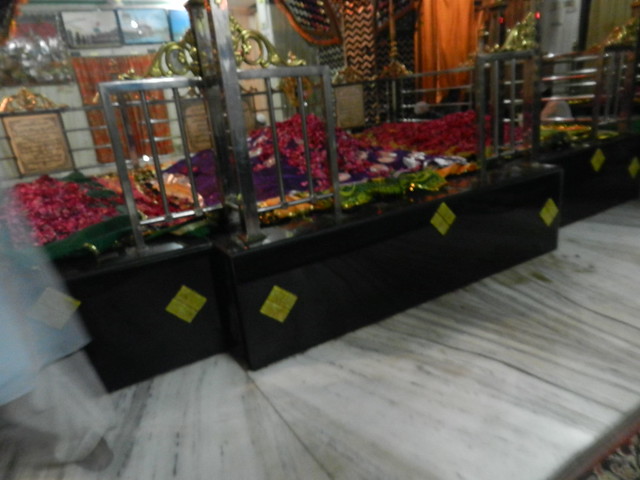By Kashif-ul-Huda, TwoCircles.net
UP close UP series: Part 7
In his authoritative and much referenced book “The Indian Muslims” author M. Mujeeb mentioned Bareilly only once and that too in the context of Bakht Khan marching to this town en route to Delhi to participate in the war against the British forces. This is an indication of how little research work has been done on a major strand of Islam in South Asia.
Bareilly is the birth place of Ahmad Raza Khan and followers of his teachings are called Barelvis. Unlike Deobandis who didn’t mind being called after the town where their main madrasa Darul Uloom is established, Barelvis preferred the term “Ahal-e-Sunnat wal Jamaat” for themselves. The name differentiates them from Shias and puts forth their claims of being the only true Muslims.

Darul Ifta at Bareilly. [TCN Photo]
Saudagaran, a mohalla of Bareilly lined with shops selling offering chadars and trinkets, souvenirs, books, CDs of speeches and naats is not much different than other dargah towns of the Sufi circuit. But about a hundred years ago, Ahmad Raza Khan [1856-1921] referred by his follower as “Aala Hazrat” lived and worked in this neighborhood.
It was a tumultuous period. In the aftermath of the fall of Delhi in 1857, Muslims of Delhi and nearby regions bore the brunt of the British revenge. Seeing their political influence gone, Muslims were trying desperately to hold on to their economic fortune all the while making sense of the rapidly changing world around them. Ahmad Raza Khan was of Rohilla ancestry, Pathans who took active part in the war of 1857 and suffered much as a result. It was Ahmad’s grandfather Riaz Ali Khan who instead of military service chose to become a scholar. Maulana Naqi Ali Khan [1831-80], Ahmad’s father was also a scholar and was known in Bareilly as a prominent person.
Ahmad Raza Khan who studied Dars-e-Nizami from his father was a brilliant scholar. He spread his interpretation of Islamic teachings by writing books and fatwas covering a range of topics from philosophical questions to mundane affairs. With the help of better communication facilities and printing presses, his message and fame spread far and wide.
When I visited Bareilly, months before UP Assembly elections, banners of Ittehad-e-Millat Council (IMC) was visible everywhere. It is a political party launched by Tauqir Raza Khan, a descendent of Ahmad Raza Khan. A hundred years ago when Muslims all over India were caught up in the Khilafat Movement, Ahmad Raza opposed it as being political and chose to focus on religious issues. Years later, Ahmad’s eldest son Hamid Riza Khan rejected freedom of India as a goal. Speaking at All India Sunni Conference of 1925 he argued that freedom would amount to Hindu raj and therefore Muslims should work for the education and economic upliftment of the community.
Post-independence Barelvis stayed away from politics, which now they think is the reason that all plum posts of waqf councils and hajj committees have gone to their bête-noir Deobandis or “Wahabbis” as the Barelvis like to call them. Tauqir Raza Khan’s IMC was successful in winning one assembly seat; choice of “Ittehad-e-Millat” (Community Unity) name for the first Barelvi political outfit was rather interesting.
Ahmad Raza Khan did not hesitate in calling Deobandis, Jamaat-e-Islami, Ahl-e-Hadis as kafirs, even today his followers do the same. It was not Deoband but Ahmad Raza who called Syed Ahmad Khan a kafir. “The nechariya [Sir Sayyid Ahmad and his followers] have no relation to Islam. They are kafirs and murtadds, as they deny the zaruriyat-e-deen. Although they read the kalima, and accept the qibla of the Muslims, this is not sufficient to make them ahl-e-qibla and Muslims,” wrote Khan in fatawa al-haramain bi-raif nadwat al-main.

Aala Hazrat’s grave in Bareilly. [TCN Photo]
But there is no evidence to show that Ahmad Raza was a British agent, as alleged by the Deobandis,. The museum in Bareilly holds letters mailed by Khan that have postage stamps affixed upside down, his way of protesting the British Empire. But he was not a political man and until now even his followers barring few individuals did not take up politics.
Ahmad practiced and preached a narrow version of Islam and he had no tolerance for those who did not subscribe to his rulings. Therefore a Muslim League that takes support from groups that he considered kafirs cannot be supported. Similarly, Pakistan if open to others cannot be a Muslim homeland.
Lately Barelvis have started flexing their political muscles, portraying themselves as Sufi and moderate Muslims while calling Deobandis as Wahabbis and extremists. Barelvis and Deobandis both position themselves as belonging to the Hanafi School of jurisprudence and while Barelvis are mostly Qadiris, Deobandis are usually of Chishti Sufi order. Calling all those not Deobandi, Ahl-e-Hadis, or any other sect as belonging to Ahle Sunnat wal Jummah, Barelvis are quick to call themselves as the largest of the Muslim group in India. And they will be right if one accepts that definition but taking a stock of masjids or madrasa we will find most will be categorized Deobandis.
In small towns and rural areas, Barelvis refusal to accept Deobandis as true Muslims causes much confusion and tension among common Muslims. Seeing the name of Ittehad-e-Millat, I asked Aamir, an Engineering student and my Bareilly guide whether Shias and Deobandis are part of this millat? He replied “We may have differences but for outsiders we are going to present a united front.” I was relieved because just a few minutes earlier he had placed me in the non-Muslim category.
Reference:
Sanyal, Usha. Devotional Islam and Politics in British India: Ahmad Riza Khan Barelwi and His Movement, 1870-1920. 3rd edition. Delhi: Yoda Press, 2010. (1st and 2nd eds. New York and Delhi: Oxford University Press, 1996 and 1999.)
Slide show:
